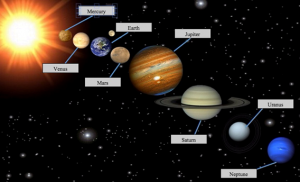The solar system consists of the Sun; the eight planets, more than 130 satellites of the planets, and a large number of small bodies
The planets are divided into inner or terrestrial planets which have higher densities e.x. Mercury, Venus, Earth and Mars and outer planets which have lower densities e.g. Jupiter, Saturn, Uranus and Neptune.

1. Mercury
- Mercury is the closest planet to the Sun. It orbits in a highly elliptical orbit ranging from 46 million km (29 million miles) from the Sun out to 70 million km (43.5 million miles).
- It takes about 88 earth days to orbit the sun but rotates on it’s axis once every 59 earth days. Because of the slow rotation, a single day on Mercury (mid day to mid day) takes 176 Earth days.
- It has no atmosphere and no satellite.
- Its days are scorching hot and nights are frigid.
2. Venus
- Venus is the second closest planet to the Sun and orbits in an almost circular orbit at 108 million km. As it orbits, Venus comes closer to earth than any other planet in the solar system and can come to within about 40 million km.
- Venus takes about 225 earth days to orbit the Sun and rotates at the incredibly slow rate of once every 243 days – and in a clockwise direction
- Venus is considered as ‘Earth’s-twin’ because its size and shape are very much similar to that of the earth.
- It is also called the ‘morning’ or ‘evening star’.
- It is probably the hottest planet because its atmosphere contains 90-95% of carbon dioxide.
- It has no satellite.
3. The Earth
- The third closest planet to the sun is earth and is the largest and densest of the inner planets. Earth orbits in a reasonably circular at 150 million km and is the first of the planets to have a moon
- Earth takes 365.25 earth days to orbit the Sun and rotates once every 23 hours, 56 minutes and 4 seconds. Because it rotates around the sun the length of a day on earth (sunrise to sunrise) takes 24 hours.
4. Mars
- Mars is the fourth closest planet to the Sun and orbits in an fairly eccentric orbit at around 230 (+-20) million km.
- Mars takes about 686 earth days to orbit the Sun. It has a tilt (25.1 degrees) and rotational period (24 hour 37 minutes) which are both similar to the earth with a day (sunrise to sunrise) lasting 24 hours, 39 mins. Because of the tilt it also has seasons in the same way as the earth does.
- Beneath its atmosphere, Mars is barren, covered with pink soil and boulder. Because of this it is known as ‘red planet’.
- Phobos and Deimos are two moons of mars
5. Jupiter
- Jupiter is the fifth closest planet to the Sun and is the first of what are called the outer planets (being outside the asteroid belt). It is by far the largest planet in the solar system having two and a half times as much mass as all the other planets put together and one thousandth the mass of the Sun.
- Jupiter orbits the Sun once every 12 years.
- It is presumed to have a rocky core surrounded by a sea of liquid metallic hydrogen which forms a ball 110,000km in diameter.
- Europa, Ganymede and Callisto are the important moons of Jupiter
6. Saturn
- Saturn is the sixth closest planet to the Sun. It is the second largest planet in the solar system having a radius 9 times that of earth (57,000 km) and a mass 95 times that of earth.
- Saturn orbits the Sun once very 29 years (at about 1400 million km) and is mainly comprised of gas (96% hydrogen and 3% helium) and is presumed to have a rocky core surrounded by a sea of liquid metallic hydrogen which forms a ball some 56,000km in diameter.
- The upper layers are thought to comprise of liquid water, ammonium hydrosulfide, hydrogen and helium.
- It has 21 known satellites. Among them Titan, Phobe, Tethys and Mimas are important.
7. Uranus
- It is the only planet that lies on its side. Hence, one pole or the other faces the sun as it orbits.
- It is one of the coldest planets because of having an average temperature of -223?C.
- Its atmosphere is made of mainly hydrogen. The landscape is barren and there is frozen
- methane cloud.
- There are 9 dark compact rings around the planet and a corkscrew shaped magnetic
8. Neptune
- It is the most distant planet from the sun.
- There are five rings of Neptune. The outer ring seems to be studded with icy moon lets while the inner ring appears narrow and nearly solid.
AffairsCloud Recommends Oliveboard Mock Test
AffairsCloud Ebook - Support Us to Grow
Govt Jobs by Category
Bank Jobs Notification




